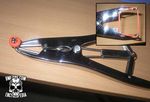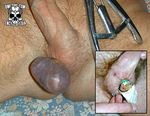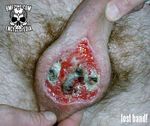Elastrator: Difference between revisions
(Created page with "<html><div class="mw-content-ltr" dir="ltr" id="mw-content-text" lang="en"><p><br/> An <b>elastrator</b> is a <a href="/index.php?title=Castration" title="Castration">castration</a> device that cuts off circulation to the <a href="/index.php?title=Testicle" title="Testicle">testicles</a> when utilized, called "elastration." An elastrator basically stretches a strong rubber band over the <a href="/index.php?title=Scrotum" title="Scrotum">scrotum</a> and above the testicle...") |
(Page conversion via llm-mediawiki-rev -jwm) |
||
| Line 1: | Line 1: | ||
'''elastrator''' is a [[Castration|castration]] device that cuts off circulation to the [[Testicle|testicles]] when utilized, called "elastration." An elastrator basically stretches a strong rubber band over the [[Scrotum|scrotum]] and above the testicles. When the band is secured, the testicles are tightly tied off at the base of the scrotum and allowed to die from lack of [[Blood|blood]]. This process can take up to six or more hours, but in some people, irreversible damage may occur within the first hour of applying the band. | |||
Those who have successfully utilized this method report that the pain is agonizing for the first twelve hours, but after that, the feeling dulls until the testicles are entirely dead. At this point, the entire scrotum and testes can be cut off below the band without any pain or bleeding. The band is left on until the area is healed enough to hold together on its own. This method of castration is commonly done on farms and is also the method favored by home ([[DIY|DIY]]) and [[BDSM|BDSM]] practitioners, due to its relative simplicity and safety. An added benefit to this method is that it also removes the scrotum during the process of destroying the testicles. If the scrotum is left on, [[Sepsis|sepsis]] (blood poisoning) and [[Infection|infection]] are very real risks if [[Dry Gangrene|dry gangrene]] doesn't set in like it should. On the other hand, if the band is removed too soon after removing the scrotum, major and uncontrollable [[Bleeding|bleeding]] is risked. | |||
{| class="wikitable" style="text-align: center;" | |||
|- | |||
| [[File:Elastrator-1.jpg|150px|thumb|right|Elastrator]] | |||
| [[File:Elastrator-2.jpg|150px|thumb|right|Elastrator]] | |||
| [[File:Elastrator-3.jpg|150px|thumb|right|Elastrator]] | |||
|} | |||
Elastrators are a veterinary tool — available no-questions-asked through farm supply companies — and are not "approved" for use on humans and are certainly not considered safe by the medical community — unlike the [[Burdizzo|Burdizzo]], another DIY farm-castration tool. However, like most castration devices designed for use by relatively untrained farmers, it is able to provide cheap castrations with a minimum of livestock loss. | |||
== See Also == | |||
* [[Burdizzo|Burdizzo]] | |||
* [[Castration|Castration]] | |||
* [[Eunuch|Eunuch]] | |||
* [[Banding|Banding]] | |||
Latest revision as of 03:08, 17 September 2023
elastrator is a castration device that cuts off circulation to the testicles when utilized, called "elastration." An elastrator basically stretches a strong rubber band over the scrotum and above the testicles. When the band is secured, the testicles are tightly tied off at the base of the scrotum and allowed to die from lack of blood. This process can take up to six or more hours, but in some people, irreversible damage may occur within the first hour of applying the band.
Those who have successfully utilized this method report that the pain is agonizing for the first twelve hours, but after that, the feeling dulls until the testicles are entirely dead. At this point, the entire scrotum and testes can be cut off below the band without any pain or bleeding. The band is left on until the area is healed enough to hold together on its own. This method of castration is commonly done on farms and is also the method favored by home (DIY) and BDSM practitioners, due to its relative simplicity and safety. An added benefit to this method is that it also removes the scrotum during the process of destroying the testicles. If the scrotum is left on, sepsis (blood poisoning) and infection are very real risks if dry gangrene doesn't set in like it should. On the other hand, if the band is removed too soon after removing the scrotum, major and uncontrollable bleeding is risked.
Elastrators are a veterinary tool — available no-questions-asked through farm supply companies — and are not "approved" for use on humans and are certainly not considered safe by the medical community — unlike the Burdizzo, another DIY farm-castration tool. However, like most castration devices designed for use by relatively untrained farmers, it is able to provide cheap castrations with a minimum of livestock loss.


